Several newer feed resources have been evaluated and found useful for livestock feeding. There is a need to upscale these technologies for wider application. Of late certain local feed resources like azolla, areca sheath, maize kadbi, fruit residues, ayurvedic residues, brewery and residues have been found useful and farmers have started using some of them in the livestock ration. Use of these alternative feed resources replacing part of conventional feed ingredients is wise way for sustainable livestock production. Some of such potential feed stuffs are discussed in this article.
Dry Fodder Resources
Areca sheath
In some regions of Karnataka, Kerala and Assam, the areca (Areca catechu) cultivation as a commercial crop has partly replaced the traditional cereal crops due to higher economic returns. This has resulted in deficit of dry fodder, especially in the costal zones of Karnataka and livestock farmers are procuring paddy straw from adjoining districts at higher cost. The analysis of areca sheath for its nutritional composition has showed almost similar composition to paddy straw. Research at ICAR-NIANP has shown no untoward effect due to feeding of dried areca sheath to sheep and cows. For efficient utilization of dried and shredded areca sheath in the form of total mixed ration along with suitable proportion of concentrate feed is recommended. Suitable machine to shredd the dried areca sheath is commercially available. In Andaman islands also areca sheath as dry fodder is becoming popular. In India, the potential availability of areca sheath is about 1.20 million tones, annually and can be a valuable resource. Apart from the whole sheath, the residue left after making plates also can be used as dry fodder.

Sugarcane trash
Sugar cane dry trash and is a part of sugar cane tops and is a major by-product of the sugarcane industry which is left in the field after sugar cane harvest. The major states producing sugarcane are UP, Maharashtra, Karnataka, Tamil Nadu, Andhra Pradesh, Telangana, Bihar, Gujarat, Haryana, Uttarakhand and Punjab. With a cane to dry leaf ratio of 2-3 %, about 6.8-10.3 million tonnes of sugar cane trash is expected to be available at the time of harvest in India. The trash can be fed to livestock as a replacement of dry fodder like paddy straw or finger millet straw in situations of drought. Sugarcane trash is very bulky material and occupies lot of space. This can be a major drawback during transportation. This can be avoided if trash is chaffed to small pieces with the help of mechanical chaff cutter (4-6 inches). Research conducted at ICAR-NIANP has shown that sugarcane trash is good source of fiber (NDF: 32.3%), and hemi-cellulose (26.9%). However, contains less protein (3.54%), similar to paddy/finger millet straw (3.65%) and can replace cereal dry fodders for livestock feeding.

Maize stover and cobs
Maize crop is being cultivated on a large scale due to the high demand for maize grains for feed, starch industry and distilleries. Maize stovers and cobs are the by-products that are currently being either not utilized or underutilized. Stover and cobs can be used as roughage source in diets of cattle, buffalo, sheep and goats. Simple interventions like chaffing of maize stovers and cobs will facilitate the effective utilization of untapped feed resources. Maize stovers in general after harvesting the cobs are either left in the field itself or sometimes burnt in the field to make way for the next crop. The nutritive value is almost similar to any cereal dry fodder. The cobs can be shredded and compressed into blocks for easy transportation.

Sunflower heads
Sunflower head is a residue after extraction of seeds. Crushed sunflower head has a crude protein content of 7-10%, fibre content of 45-50% and dry matter digestibility of 50-55%. It can be included in total mixed ration upto 40% as roughage source. Research conducted at ICAR-NIANP has shown no adverse effects after feeding sunflower head based total mixed ration.

Haulms of Groundnut and horsegram
The leafy residues of ground nut and horse gram (top feeds) are leguminous in nature and has better protein and digestible fibre value as compared to cereal dry fodders. Ruminant animals, particulary sheep and goat relish them very much. These top feeds can be dried and stacked to use as dry fodder.

Fruit and Vegetable Residues
In many Asian countries, there is a gradual shift in the cropping pattern from cereals to more remunerative fruit and horticultural crops. This results in generation of huge quantity of fruit and vegetable residues. Presently such residues are not effectively used and dumped in landfills causing environmental pollution. There is a need to develop suitable methods to convert waste to wealth and contribute to value added feed resources. Some of the potential fruit residues that can be used in feeding are mentioned below.
Apple
In India annually about 1.74 million tonne of apple is produced and waste consists of peels, seed and pulp, which represents 25-35% of fresh apple. The apple pomace on dry matter basis consist of 4.72% crude protein and 48-60% total sugar. It is a good source of energy (75% TDN) and can replace 30% maize grain in ruminant ration. The residue contains high moisture and can be dried in sunlight or at 65% moisture level can be made as silage for preservation to use as feed.

Grape
Grape pomace is a by-product of wine industry comprising grape pulp, skin, stem and seeds accounting about 20% of the grape fruit. The annual production is about 1.6 million tonnes and limited quantity is processed for wine. On dry matter basis, grape pomace contains 11% crude protein, 27% crude fiber and 5% lignin. Due to lignified fiber, the digestibility and energy value is low. The dried pomace has phenolic anti-oxidant compounds. Due to lower nutritive value grape pomace can be used in smaller quantity in ruminants feeding.
Mango
Majority of the mango is consumed freshly and only about 2% is processed and generates 40-50% waste. The waste include peels, juice extraction waste, seeds and kernel. The waste has more sugar and moisture and hence need to be dried and made silage for preservation. The silage of peels and juice extraction waste is a good source of energy(70% TDN). The seed kernel represent about 50% of the whole seed and contains 7-12% oil and 40% starch on dry matter basis. Boiling and autoclaving will remove certain anti-nutritional factors like cyanognic glycosides, oxalate and trypsin inhibitors. Though protein content of mango seed kernel is low and quality in terms of amino acids is good.
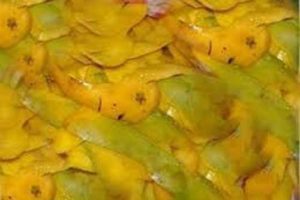
Citrus fruit by-products
The by-products of orange and lemon are peel and rag. About 40-50% waste is generated from citrus juice industry and contains soluble sugars. It can be made as silage along with dry fodder and used as cattle feed.
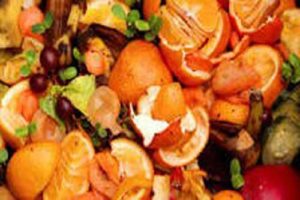
Banana fruit by-product
The banana fruit waste like peels contains more moisture, low protein and more soluble sugars. This can be preserved as silage along with dry fodder and fed to cattle with other feeds.
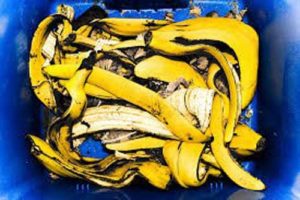
Pineapple fruit residue
The residue include leafy crown, peels and the pomace of juice extraction. Less than 30% of the pineapple fruit produced is processed in industry and more than 60% of the whole fruit is not edible for human consumption. The pineapple fruit residue on dry matter basis contains 6-7% crude protein 50% total sugar, and 70% energy(TDN). The residue can be chaffed and dried to less than 10% moisture and use as hay. Otherwise, after draining the excess moisture, the waste can be made as silage and can be used as a fodder source for cattle / sheep. Study at ICAR-NIANP has shown that nutritive value is better than maize green fodder. Ideal proportion of leafy crown and peel/pomace for silage making is 4:1(w/w).

Jack fruit residue
Jack fruit is a common horticultural crop in many Asian and African regions. In India about 1.2 million tonnes of jack fruit is produced leaving a residue of 0.8 million tonnes per year. This residue (skin, aerial parts) is inedible for human consumption and quickly putrifies due to high sugar and moisture content. Study at ICAR-NIANP has shown that jack fruit residue (JFR) contain crude protein (6-7% on DM basis), total sugars (60-65% on DM basis) and higher organic matter digestibility (70-78%). It is palatable and can be fed to ruminants as fodder source along with supplementary nitrogen(urea/tree leaves/oil cake). The chaffed fruit residue can be ensiled for preservation or dried to less than 10% moisture content and ground to use as jack bran. Nutritive value of jack bran is better than any dry fodder and almost similar to medium quality green fodder.
Tomato pomace
India ranks second in the world in tomato production contributing 10.82% of world production. Tomato pomace is major by-product of tomato processing industries. The production of tomato pomace is seasonal and linked to harvest period. Most of the product is available during late warm-season and drying is necessary for storage. Sun-drying or artificial drying is the preferred method and resultant product is crispy and it can be mixed along with other feeds and use as roughage source.
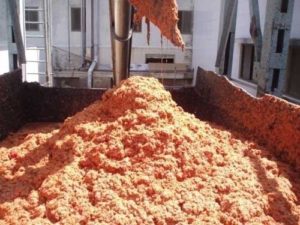
Hydroponic grain sprouts
Producing the green feed through germination of grains like maize, barley, oat or wheat produces consistent quantities of green feed throughout the year at the rate of about 4 to 6 kg per kg of seed within 10 days period. It is essentially a hydroponic technique, where the sprouted seeds spread over the trays grow into green feed in a 10 day cycle. There is about 18-20% dry matter loss and often mold growth is a problem. Soaking the seeds with 4% vinegar solution is quite effective in preventing mold growth. Quality of seeds, moisture management and control of predators (squirrel, rodents) are some of the issues in grain sprout production. Improved method of grain sprouts cultivation with straw bedding has been developed by scientists of ICAR-NIANP. It can be considered as a contingency strategic green feed supplement along with dry fodder rather than alternative to conventional green fodder source. On dry matter basis, the nutritive value of grain sprout in terms of protein, energy and fibre is almost similar to good quality wheat bran.

Cactus
Spineless cactus is climate resilient and can grow on low fertile rocky soil and with less water. It will suit most for arid and semi-arid regions. The blades (cladodes) of cactus contain high moisture (>85%) and less protein(4-5%). This can be used as a supplementary fodder for livestock along with other cultivated fodders.

Azolla
Azolla (A. Pinnata, A. nilotica,) a water floating fern and triangular in appearance, consisting of roots, stems (rhyzomes) and leaves. Azolla grows in symbiotic association with a blue- green alga Anabaena azollae, a nitrogen fixing organism. Azolla is a promising supplementary green feed from the point of ease in cultivation, productivity and its nutritive value. Azolla is a protein rich green feed, leucine, lysine, arginine and valine are the predominant amino acids in Azolla, while tryptophan and sulfur containing amino acids are deficient. Azolla is also rich in vitamin A, vitamin B12, Beta- carotene, growth promoting intermediaries, bioactive compounds and bio-polymers and azolla is well digested by livestock. Azolla generally grow best in less than full sun light. Optimum relative humidity for Azolla growth is 60-75% and pH range of water is 5.5-7. The use of Azolla as a green feed for fish, swine, poultry and cattle has been tested with favourable results. The chemical analysis of Azolla showed that it is a good source of protein (20-25%) and most of the minerals. Azolla can be used as a valuable green feed protein supplement mixed with crushed maize grain or wheat / rice bran. This is very useful under low input livestock production system.

Fodder trees
Providing top feeds from the trees will help to bridge the deficit of green fodder. In dry regions, their utility is much more realized. Trees like Sesbania, Subabul, Gliricidia, Melia etc. perform well even in dry lands. The normal farmers’ practice of lopping only the side branches and allowing the uninterrupted growth of main stem reduces the yield. Instead, main stem is to be pruned to a height of 5 feet when the trunks of fodder trees are about 1.5 inches in diameter. Normally, it takes about 8 to 10 months to reach this stage. After the first lopping, subsequent harvests can be done at an interval of around 60 days. Most of the tree leaves have a protein content of 18-20%, fibre content of 30-35% and calcium content of 1-2%. Tree leaves can be fed to meet 10-15% of total protein requirement. Besides, most tree leaves possess tannins and can be a good source for methane mitigation in ruminant diets.

Miscellaneous ingredients
Neem seed cake
Neem seed kernel meal, a by-product after neem oil extraction. is high in crude protein (36-38%) and as such, found unsuitable feeding due to presence of bitter and toxic triterpenoids (azadirachtin, salannin, nimbin, nimbidiol etc.). Detoxification can be done by alkali soaking with 1.5% NaOH. Studies have indicated that detoxified neem cake can replace 50% soybean protein in total mixed rations of cattle.

Karanj seed cake
Karanja is a forest tree belonging to the family Leguminosae, grown in all parts of India, particularly in Tamil Nadu, Andhra Pradesh and Karnataka, for its ecological advantages. Karnaj seed cake, a by-product of karanj oil extraction is rich in protein, but unpalatable and toxic due to the presence of karanjin, pongamol and an unusual amino acid, glabrin. Detoxification of karanja cake can be done by complete removal of oil and refluxing with solvent. Detoxified material could replace 50% of soybean meal in total mixed rations dairy cattle.

Castor seed cake
Castor seed cake is a by-product of the castor seed industry, contains fairly good amounts of protein (CP: 35%). It can be a substitute of conventional oil cakes like soybean meal in livestock diets but for the presence of a toxic glycoprotein, ricin. Lime treatment (4.0%, w/w) followed by extrusion cooking results in ricin free castor seed cake. Such treated cake could be a protein supplement upto 10% level in the total mixed ration of cattle.

Guar seed meal
Guar meal is the by-product after extraction of gum from guar seeds. It consists of the outer seed coat and the germ of guar seeds. It is a potential source of protein and has been used to feed livestock and poultry. Guar meal has to be toasted before it is fed to livestock to destroy trypsin inhibitors. It can induce chronic diarrhoea when fed as the sole feed to growing calves. Guar meal has a residual gum which is an indigestible polysaccharide that leads to sticky faeces. It is a good source of amino acids like lysine, cysteine and glycine than ground nut cake but methionine content is comparable to standard protein sources. The guar seeds are toasted to high temperature to remove the trypsin inhibitor so that, the nutritive value improves. The meal is a by-product obtained after processing of seeds. Guar meal is one of the important ingredients used as cattle feed and contains upto 55% crude protein along with digesting content which makes it a reliable and safe ingredient for animals.

Rain tree pods
Rain tree is widely distributed in the tropics. A mature tree can yield 500-600 kg green forage foliage and 250-300 kg pods. Ripened pods are fallen from tree from February to April months. Rain tree pods are a good source of crude protein (15.3%), sugars (69.9%) and low crude fiber (10.0%) and can be a substitute for good quality rice bran. Small quantity of crushed pods can be fed to cattle mixed with urea as per recommended level.

Hotel food and kitchen waste
Disposal of food waste generated by hotel industries is an enormous challenge. There is enormous opportunity for utilizing these wastes as feed for livestock. There should be a mechanism to collect food wastes from the hotels and transporting to livestock farms. The vegetable and vegetarian food wastes can be fed to dairy animals along with other concentrates and roughages. However, the wastes need to be cooked or heat treated or microbiologically treated before offering to cattle to ensure that they are bacteria free and edible. Generally left over food and vegetable in domestic kitchen are fed to cattle. Generally ruminant are fed food residues of vegetarian source and pig are fed mixture of both.
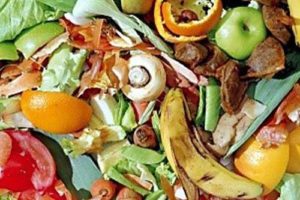
Brewer’s grains
Brewer’s grains are materials remaining after fermentation of grains during the liquor / beer making process. These materials can be fed in the wet form (wet brewer’s grain) or dried form (dried brewer’s grain). The nutritional content varies depending on the type of grain used (barley, wheat, corn, sorghum). Dried brewer’s grain contains 22-25% protein on dry matter basis. It is a good source of high quality bypass protein and digestible fiber. It is usually recommended to include dried brewer’s grains up to 20-25% of the concentrate mixture and up to 15% of the total dietary dry matter of adult ruminant diet. Wet Brewer’s grains have limitation of low shelf life (less than 2 days) and hence to be used without spoilage. Wet edible Brewer’s grains can be mixed with crushed maize grain or wheat bran at 5 : 1 ratio and feed to cattle to balance energy and protein.

Ayurvedic medicinal residues
Indian ayurvedic industry has a turnover of around Rs. 3500 crores with 7-10 per cent annual growth rate. It is estimated that there are over 7800 medicinal drug- manufacturing units in India, includes 14 well-recognized and 86 medium scale manufactures of herbal drugs, producing ayurvedic preparations employing thousands of tons of herbs. Thailam (oil based) and Kasayam (decoction) are the major available Ayurvedic medicinal residues. The thailam residues have higher crude protein and oil content ranged from 21-27% and 11-23% respectively, whereas Kasayam residues were mostly fibrous with low protein content ranges between 5.5 to 6.5% on DM basis. The potential of Ayurvedic medicinal residues as livestock feed has not been fully explored. Study conducted in goat at ICAR-NIANP using Thailam Ayurvedic medicinal residues viz. Ksheerabala (K) and Dhanwantharam (D) has shown that 40% of Soybean and groundnut cake protein can be replaced with the above ayurvedic residues without adverse effects on health and production (22.7 kg Ksheerabala and 25.4 kg Dhanwantharam per 100kg concentrate mixture). The cost of feeding was also reduced by 18-20%.
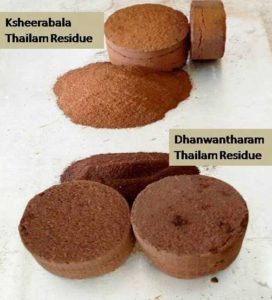
Conclusion
Strategies for strengthening the feed / fodder base should focus on regional availability and suitability of potential resources. Use of certain non-traditional feed stuffs lessen the dependency on conventional ingredients. A major drawback in the use of the non-traditional oil seeds is lack of appropriate processing methods that are not only effective to neutralizing the toxins but are economical and simple enough to be taken up by the processing industries. Perception of end users about the technology and their involvement in technology validation is a key to its successful adoption. Local milk unions, krishi vigyana kendras, organised livestock farms and village level self-help groups should act as sub-centres of technology transfer and harness benefits of these innovations.
References
- Abdollahzadeh, F., Pirmohammadi, R., Fatehi, F. and Bernousi, I. 2010. Effect of feeding ensiled mixed tomato and apple pomace on performance of holstein dairy cows. Slovak Journal of Animal Sciences, 43(1):31-35.
- Bakshi, M.P.S. and Wadhwa, M. 2013. Nutritional evaluation of cannery and fruit wastes as livestock feed. Indian Journal of Animal Sciences, 83(11): 1198-1202.
- Gark, A.K. and Digvijay Singh. 2011. Increasing availability of green fodder through a sustainable approach for fodder seed production. Indian Dairyman, 11:54-60.
- Gowda, N.K.S. 2016. Areca sheath as an alternate dry fodder for livestock. In: Broadening Horizons, FAO, Feedipedia, 29 May 2016, www.feedipedia.org, pp 1-2.
- Gowda, N.K.S. and Vijay Bhasker, T. 2017. Fruit residues as alternate forage resources for livestock. In: Approaches towards fodder scarcity in India. (Eds.) Ghosh, P.K., Mohanta, S.K. et al., Studera Press, New Delhi, PP. 534-550, ISBN 978-93-85883-43-9.
- Gowda, N.K.S., Manegar, A, Verma S, Vallesha, N.C. Maya, G., Pal, D.T. and Suresh, K.P. 2015. Azolla (Azolla pinnata) as a green feed supplement for dairy cattle – An of farm study. Animal Nutrition and Feed Technology, 15: 283-287.
- Gowda, N.K.S., Vallesha. N.C., Awachat, V.B., Anandan, S., Pal, D.T. and Prasad, C.S. 2015. Study on evaluation of silage from pineapple (Ananos comosus) fruit residue as livestock feed. Tropical Animal Health and Production, 47: 557-561.
- Indira, D., Sarjan Rao, K., Suresh, J., Venugopal Naidu, K and Ravi, A. 2009. Azolla (A. pinnata) as feed supplement in buffalo calves on growth performance. Indian Journal of Animal Nutrition, 26(4): 345-348.
- Kusmartono. 2007. Effects of supplementing jack fruit wastes with urea or gliricidia / cassava leaves on growth, rumen digestion and feed degradability of sheep fed on rice straw basal diet. Livestock Research for Rural Development, 19(2): 1-11.
- Muthuramalingam, T., Pothiappan, P., Tensingh Gnanaraj, P., Meenakshi Sundaram, S. and Pugazhenthi, T.R. 2015. Studies on growth performance of goats fed hydroponic maize fodder. Indian Veterinary Journal, 92(4):94-96.
- Prakash Kumar Rathod and Sreenath Dixit. 2019. Green fodder production : A manual for field functionaries. Publication of ICRISAT, Patancheru, Telangana, 56 pp.
- Rao, S.B.N. Gowda, N.K.S., Soren, N.M., Pavan Kumar, M.A., Awachat, V.B., Karthik Bhat, S., Prasad, K.S. and Ramachandra, K.S. . 2019. Nutritional evaluation of sugar cane trash as dry fodder source for cattle. Indian Journal of Animal Sciences. 89(6): 667-670.
- Sharma, R.K., Rastogi, A. and Haq, Z. 2016. Top feeds for sustainable and ecofriendly small ruminant production. In: Dutta, N., Jadhav, S.E., Kala, A., Gopi, M., & Ramana, J.V. (Eds.), Newer perspectives in Animal Nutrition Research for Augmenting Animal Productivity, pp 22-35, Proceedings of X Biennial Animal Nutrition Association Conference, 9-11 November, 2018, Tirupati.
- Ventura, M.R., Pieltin, M.C. and Castanon, J.I.R. 2009. Evaluation of tomato crop by-products as feed for goats. Animal Feed Science and Technology, 154 : 271-275.
- Wadhwa, M. and Bakshi, M.P.S. 2013. Utilization of fruit and vegetable wastes as livestock feed and as substrates for generation of other value-added products. RAP Publication 2013/04, FAO 2013, (Ed), H.P.S. Makkar.



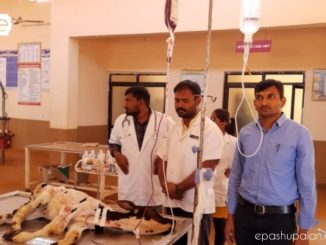
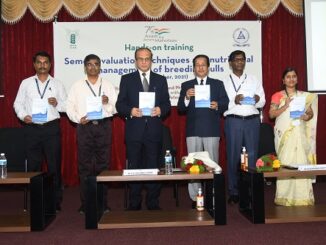

Very Good Info with value addition in least cost ration formulation.
Thanks and Best Regards
well done
Usefull article…..and helpfull too
Very informative and valuable content.
well done
superb article, well done
very good and informative article in animal nutrition
excellent
Good and informative
Very good article sir….
It is really good informative and help in field.
Nice information sir
Good and informative,
Very good article for dairy farmers
very good article sir
Informative and meticulous
The information collated in the matrix of nutrition, availability, and feasible proportions of inclusion in livestock ration is an excellent approach, considering economics, particularly when there is depletion of conventional livestock resources. The Authors need to be appreciated for the picturesque display with lucid presentation….
Information collated in terms of nutrition, availability and feasible inclusion in livestock ration is an excellent approach, particularly when there is gradual depletion of conventional livestock feed resources. The Authors need to be appreciated for the picturesque display with lucid presentation….
Highly informative article. Very useful for dairy enterpreneurs.
Very much use full for students and farming community. Excellent work done
Very useful article especially for droughtprone areas
Good informatoon
Practical application friendly
Very useful
Good information